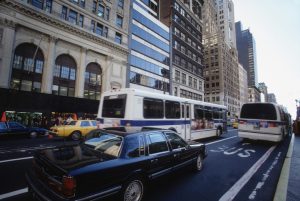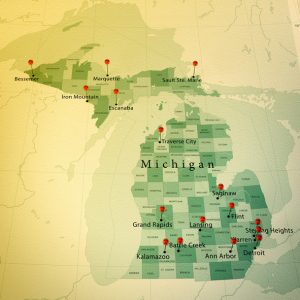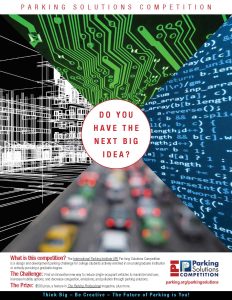

By David Hoyt
The new Mercedes-Benz Stadium (home to the Atlanta Falcons football team and Atlanta United FC soccer) opened for business in 2017. The state-of-the-art facility replaced the Georgia Dome, which was in operation since 1992. From day one, the new stadium’s owners challenged both internal and external team members to create a fan experience like no other, and from the unique architectural design elements to cutting-edge technologies inside and out, Mercedes-Benz Stadium did just that. And, by the way, the new stadium, which rivals some of the most iconic event venues in the world, includes one of the most innovative parking experiences anywhere.
If you have never been, Mercedes-Benz Stadium includes some of the most captivating features ever seen in a sports arena environment. The design includes an eight-panel retractable roof that resembles and opens like a pinwheel, allowing the stadium to open and close depending on weather and other elements.
Inside the stadium, a 360-degree “halo” cylindrical video board curves around the top, from end zone to end zone, showcasing game highlights, advertisements, and other graphics and features. Further, the stadium also features a 100-yard bar stretching the length of the football field on the upper concourse, as well as a fantasy football lounge and premium field-level club seating behind the team benches.
How parking made a difference at Mercedes-Benz Stadium in Atlanta.
Ownership continues to invest in this world-class venue by adding more entry and exit points into the stadium, creating a Home Depot Backyard fan zone, a future pedestrian bridge providing access from certain parking areas, and a nearby MARTA transit station. Ownership is relentless in providing a fan experience like no other.
Parking
One of the most critical elements to improving the fan experience was to accommodate the parking needs of the thousands of spectators arriving to events at the stadium. In a place like Atlanta, Ga., the majority of event attendees drive, so the project required the integration of numerous parking facilities and lots.
As is the case with most event operations, but particularly a 70,000-seat urban stadium, the effective and efficient movement of vehicles in and out of the parking areas can have a profound effect on the overall fan experience. Therefore, parking was one of the highest priorities to this project. In particular, a main question was how to administer a parking program that can enhance—not detract from—the arrival experience.
Designing a Program for Fans
The first step to ensuring a positive parking experience was to develop a parking program specifically designed for the fans. The project team, which consisted of team and ParkMobile staff, was tasked with creating a program that would work for all stakeholders, including suite holders, season ticket holders, single-game ticket holders, one-off event holders, VIPs, staff, third-party employees, volunteers, and the media. The project team had to account for each of these stakeholders and, in many cases, develop a specific parking strategy for each.
The parking program at the stadium had to effectively engage with the fans before their automobiles came to rest at their parking spaces. Out of those initial discussions, an interactive web interface was designed that could provide all necessary stakeholders with the ability to take their appropriate parking action remotely via multiple mediums.
This Mercedes-Benz parking reservation interface creates an efficient process for administering the appropriate parking rights to the various stakeholders. The interactive reservation system allows future parkers to select the event they are planning to attend and the parking facility or lot in which they wish to park. The platform provides the location and details of each parking area, including a map, distance from the stadium, pricing, and ease of exit. Patrons can then either print their parking pass or retrieve their pass in their stadium or parking reservation app at any time. Future enhancements will include the purchase of the parking pass via certain connected cars, allowing the fan to reserve and drive straight to a stadium parking lot via the in-vehicle navigation screen. Further, the site provides digital parking passes that are accountable and auditable, with each game or event permit being unique to that particular date and time.
As ownership only had control of a limited number of parking spaces, the project team had to engage with the area operators to secure enough parking for the fans, staff, third-party vendors, and all other stakeholders. Because the program had to provide access to all stakeholders, parking inventory had to include both prime and secondary spaces. The current program includes more than 20,000 parking spaces from seven different parking operators up to two miles away from the stadium.
The Importance of Reservations
Because the stadium was going to have a high drive ratio, getting the fans to their parking areas was critical to the success of the program. The project team knew early on that we must focus primarily on providing the ability to pre-purchase and reserve parking. While parking reservations took the guesswork out of making the parking purchase decision, providing fans with real-time routing could reduce the number of people driving around looking for their parking locations.
Thanks to a partnership with Waze, every parking permit allows for real-time routing to the parking facility entrance. Not only does this help create a more efficient and pleasant experience for parkers (and parking staff), but it also helps reduce congestion and improve safety by expediting fans directly to a parking garage or lot.
Monitoring Is Key
While the program encompasses multiple parking operators, some have embraced the concept of improving the fan experience through parking. SP+ constantly monitors event parking in real time via its command center at the Georgia World Congress Center (GWCC). Through a robust campus-wide camera system, as well as significant personnel on the ground, watching the situation in the parking areas and on the streets, ingress times are closely monitored.
This system also includes real-time tracking of how many parking passes have been purchased, as well as an inventory of vehicles and used parking spaces as facilities fill up. This information is critically important to the ability to park as many cars as quickly as possible, taking advantage of unclaimed reservations and under-used parking areas.
GWCC recently invested in additional technology that tracks all transactions down to the smallest detail and is fully integrated to accept stadium parking reservations in real time. All the data—electronic and visual—is used to make real-time decisions at the most critical time of the parking experience. The parking team evaluates its performance after every event, taking into account all the factors that influence the ingress and egress of the events—weather, score, date of the event, time of the event, etc. If there are potential improvements to be made, the team takes immediate action before the next event.
Promoting Alternative Transportation
The project team knew that promoting alternative modes of transportation would reduce congestion and improve the overall fan experience at the stadium. In addition to providing significant accommodations to attendees driving vehicles, the project team focused on creating more mobility options for those who may seek an alternative to driving.
As mentioned, there is a MARTA public transportation station next to the stadium, so people have the option to take the train if they choose. Ride-sharing is also growing in popularity, with many attendees being dropped off near the stadium by services such as Uber and Lyft. Mercedes-Benz Stadium partnered with Lyft to provide two pick-up/drop-off locations in close proximity to the stadium.
Another very unique element to this project was the promotion of bicycle transportation. Biking to the stadium is easy. The stadium partnered with the Atlanta Bicycle Coalition to provide an enjoyable riding experience, including a bike valet at most events and 250 bike racks around the stadium.
Communicating
The final step to the development and implementation of the Mercedes-Benz Stadium parking program is communication. It is extremely important to keep the fans connected and make them feel they are being served in the best manner possible, from arriving at the stadium in their vehicle, via public transportation, or even on a bike or on foot, throughout the course of the game or event, and when they leave at the end. In addition to the various applications and websites mentioned, the media has also been critical to helping get the word out to patrons.
Local Atlanta media regularly provide important information related to parking, technology, alternative-transportation options, and event tailgating. Mercedes-Benz Stadium also uses social media to a great extent to communicate directly with future customers regarding events weeks in advance and their parking and transportation options the day of their planned event.
The undertaking of such a significant new stadium, in an urban downtown setting like Atlanta, comes with a number of complications. However, after less than a year in operation, they have already seen many successful events and results, including:
- Rated No. 2 in 2017 NFL fan arrival.
- Voted No. 1 in the NFL and MLS “Voice of the Fan” surveys.
- Won the SportTechie award for most innovative venue.
- Sports Business Journal Sports Breakthrough of the Year for food and beverage experience.
- Sports Team of the Year—Atlanta United.
- Sports Executive of the Year—Arthur Blank (owner of the Atlanta Falcons).
- Hosted the 2018 college football playoff championship game.
- Future host of the 2019 Super Bowl and MLS All-Star Game, as well as the 2020 NCAA Men’s Final Four.
While the average, everyday event attendee may not necessarily make the connection, we in the parking industry understand that without an effective and quality parking and transportation program, not only would the day-to-day events be far more complicated and difficult, but it would be nearly impossible to provide the highest-level fan experience possible. The owners, managers, and decision-makers of Mercedes-Benz Stadium understood the importance of not only creating a great experience inside the stadium, but outside the stadium as well. They took into account the events of the entire event day, from arrival to departure, and went to great lengths to consider the many details of a very complicated process.
Parking and transportation issues often get lost in the details of such a significant project, yet the development of a comprehensive, intuitive, and quality parking and transportation program has helped to dramatically improve the Mercedes-Benz Stadium experience for fans from beginning to end.
Read the article here.
DAVID HOYT is senior vice president, sales and account management, with ParkMobile. He can be reached at david.hoyt@parkmobile.io.
 By Casey Jones, CAPP
By Casey Jones, CAPP

 New York City, like many urban areas, is watching bus ridership numbers fall and buses themselves get slower. It’s a cycle: More transportation options mean people opt out of the bus for cars, which means more traffic, which means slower buses, which means more people opt out, and revenue drops right along with ridership. So the city is undertaking a concerted effort to get more people on buses and then get those buses moving faster again, and they’re taking an innovative first step to get there.
New York City, like many urban areas, is watching bus ridership numbers fall and buses themselves get slower. It’s a cycle: More transportation options mean people opt out of the bus for cars, which means more traffic, which means slower buses, which means more people opt out, and revenue drops right along with ridership. So the city is undertaking a concerted effort to get more people on buses and then get those buses moving faster again, and they’re taking an innovative first step to get there. Lots is changing in the way people get from place to place, and today Forbes says the state of Michigan is at the leading edge of it all.
Lots is changing in the way people get from place to place, and today Forbes says the state of Michigan is at the leading edge of it all.

 By Todd Tucker, CAPP
By Todd Tucker, CAPP
